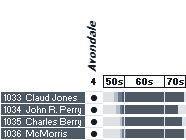
As built, the preceding Dealey was seen as expensive so the year she entered service, a new design was undertaken for production in large numbers if needed. The light displacement of the resulting Claud Jones class DEs was the same as the Dealeys but the hull form was different, with full sections aft rather than an immersed transom. Slower and with reduced armament, they were designed for four 2,400 hp diesels driving a single shaft for an improved cruising radius. The high freeboard forward with a narrow beam and low center of gravity helped improve seakeeping and accommodated engineering spaces more than 50 per cent longer than steam turbines would have required.

The design was short lived, however. On reconsidering it even before Claud Jones’ keel was laid at Louisiana’s Avondale Marine Ways, Inc. in 1957, BuShips recommended the program be terminated and only four ships were built, commissioning in 1959–60.
Length: 312' overall; 301' waterline.
Beam: 38'.
Draft: 13'.
Displacement: 1,314 long tons light; 1,916 long tons full load.
Propulsion machinery: 8,700 shaft horsepower; 1 shaft.
Design speed: 21.5 knots.
Design complement: 12 officers; 159 enlisted.
Their US Navy careers were also brief (at 14–16 years, even shorter than the contemporaneous Dealeys) but active. During the Cuban Missile Crisis, Claud Jones and John R. Perry operated from Key West while Charles Berry and McMorris operated from San Diego and Hong Kong on cruises to the western Pacific, including service off Vietnam and in the Indian Ocean. Later, all four ships were based at Pearl Harbor from where, as the last ships of Knox class joined the fleet in 1973 and 1974, they were transferred to Indonesia.
In contrast, their overall operational lifespans were among the longest of any US-built DEs: more than 40 years. Designated frigates, the Indonesian Navy’s largest ship type, ex-Claud Jones and her sisters operated as the Samadikun class for three more decades. Refitted at Subic Bay 1979–82, they were scheduled to decommission in 1986–90 when six ex-Dutch Ahmad Yani class frigates arrived, but continued in service until after the turn of the century.
Sources: Bauer & Roberts, Friedman, Silverstone.